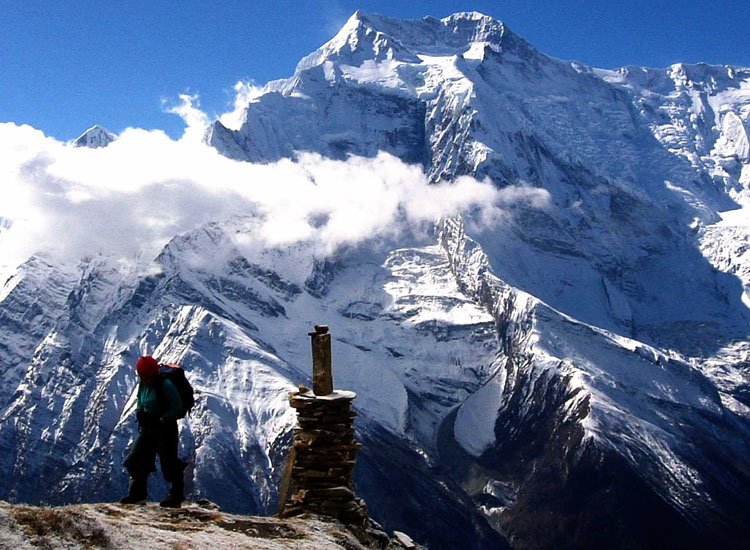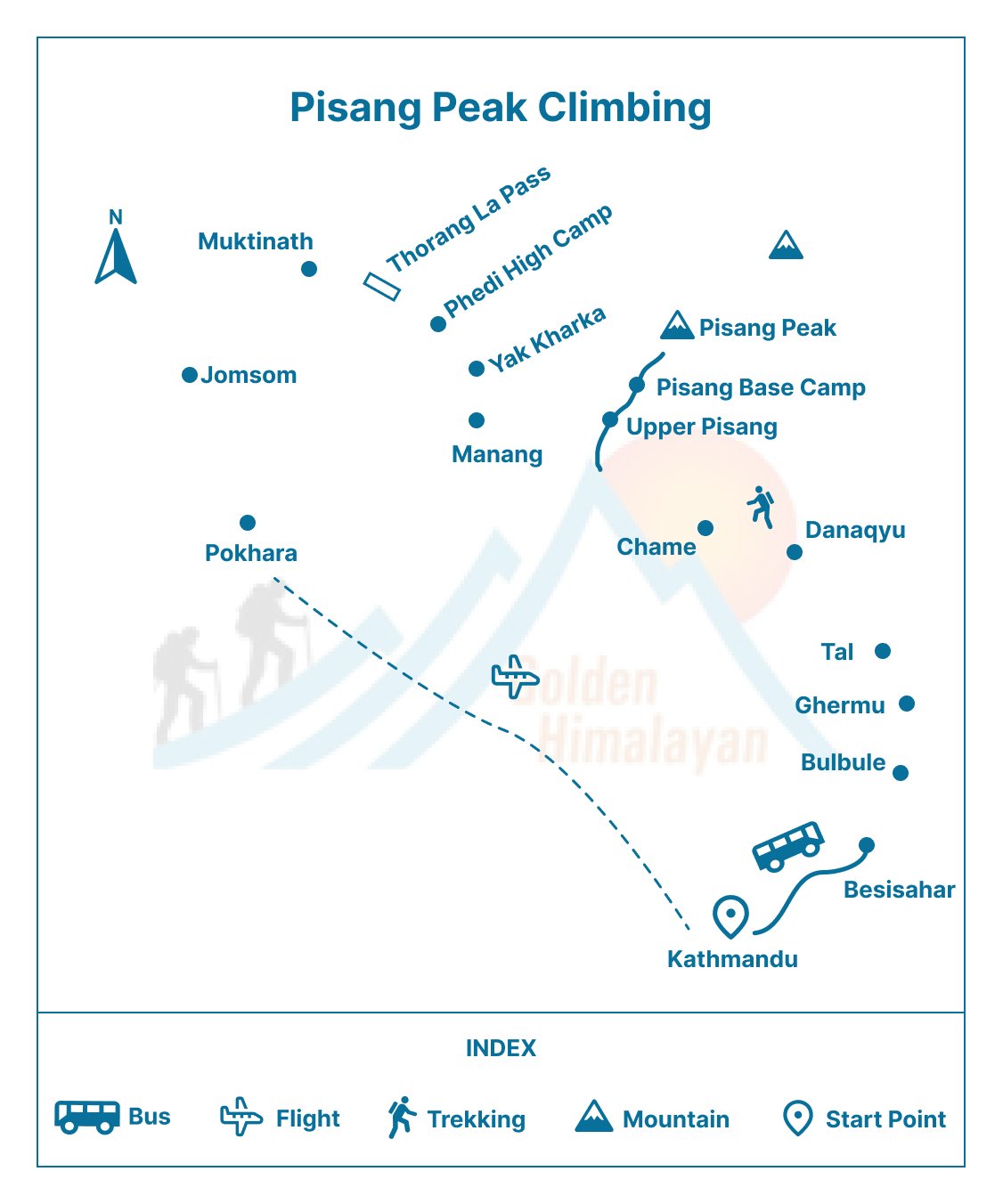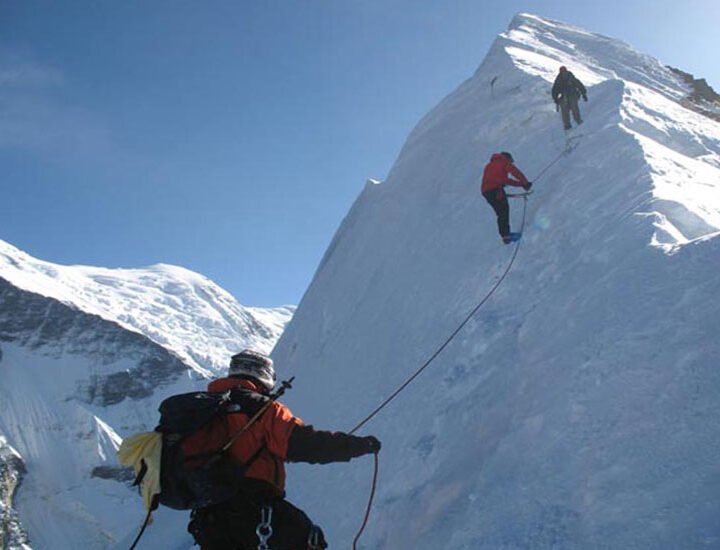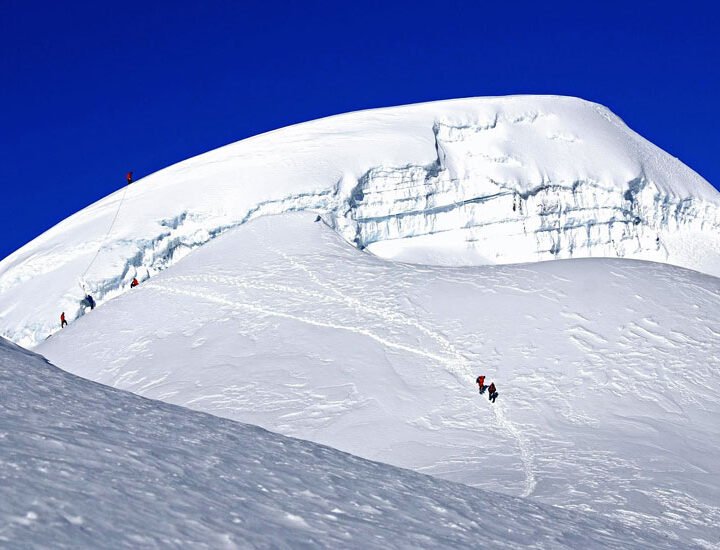- Details
Detailed itinerary
Itinerary- Tour Includes/Excludes
- Useful Info
- Map
- FAQ
Trip overview
Considered to be one of the easiest and famous climbing peaks, Pisang Peak offers a distinctive experience of exploring and peak climbing in the majestic Himalayas of Nepal. Rising opposite Annapurna II, this is one of the non-expedition peaks in Nepal and lies between the eight thousand mountains of Annapurna I and Manaslu.
After arriving at Kathmandu, you drive to Besisahar and then reach Ghermu via Bulbule. From Ghermu, you reach Tal and enter the Manang district. The rustic villages of the area like Ghermu and Tal offer you a unique culture and lifestyle of the western mountain region. You reach Chame, the gateway towards Upper Pisang, via Timang.
The Pisang peak rises above the Pisang village, and blends above the yakpastureland eloped with ice and snow. Your hike to the mountain passes through sparse forest and pasture land. The views of the Annapurna and Manaslu from the Pisang peak is spectacular. After exploring the Pisang peak and its surroundings, you hike back to Manang for the overnight stay.
From Manang, you hike towards Phedi High Camp (4850m) via Yak Kharka. From Phedi High Camp, you ascend to another famous pass- Thorong La Pass (5416m). Visit the religious site of Muktinath. Throughout this journey, you also get to experience the local culture of the Gurung and Tamang people firsthand.
This climbing is recommended to do during spring (March-May) and autumn (September-November) seasons because the weather is stable and dry, causing less rainfall and snow.
Golden Himalaya Zone aims to provide the best of the best to its customers. You get to choose the accommodation for your style. Additionally, we provide you with experienced staff and guides to accompany you on your desired trips.
Trip highlights
- Explore the unique culture and lifestyle of Annapurna Region
- Witness stunning views of the Annapurna and Manaslu peaks from Pisang Pass
- Explore the rustic village of Manang and the religious site of Muktinath
- Enjoy the views of the Annapurna range from Thorong La Pass
Itinerary
The climbing journey starts with your arrival in the country of mountains. As per your scheduled flight, you land at Tribhuvan International Airport, located in the heart of the capital city of Kathmandu. At the airport, our representatives will be eagerly waiting to welcome you warmly. After introductions, you head to the hotel to rest and refresh. Then, you meet our representatives again for a welcome dinner, and you can discuss the details of the climbing.
It is essential to prepare yourself before you depart for the trip. After breakfast, you head to Thamel to buy or rent necessary gears for the climb. Then, we’ll arrange a meeting with some experienced mountaineers and climbers, so that you can get some tips on how to climb the peak successfully. Especially if it is your first time, you must attend the meeting.
After an early breakfast, you board the vehicle that will take you to Besisahar. The drive goes along the Prithivi Highway. En route, you enjoy the scenic views of the Trishuli and Marsayangdi Rivers along with the hilly terrain. Upon your arrival at Besisahar, you rest and prepare for thetrek. Winding through the rhododendron forests for about 2 hours, you arrive at Bulbule for the overnight stay.
After breakfast, the trek resumes, and you walk along the banks of the Marsayangdi River. After walking for a while, you cross it through a suspension bridge and arrive at Bahun Danda. From there, you ascend through lush forests to reach Ghermu, which is known for its beautiful waterfall. Overnight stay at Ghermu.
After breakfast, you start to descend to Syange, and from there, you cross the Marsayangdi River via a suspension bridge. Then, you pass by settlement areas and arrive at Jagat, where you will see stone houses. You continue to walk along the ridge.Once you reach Chamje, you go down to cross the Marsayangdi River again. Then, you arrive at Tal after crossing a bamboo forest. Overnight stay.
After breakfast, you head to the village of Dharapani.The trail then winds through the landscape. After crossing several settlement areas, you arrive at Danaqyu. If you do not have the energy to walk further, you can stay here overnight. Otherwise, an hour trek will take you to Timang, where the views of the mountains are better.
You start the trek after breakfast. En route, you get to see spectacular views of Annapurna II, Lamjung Himal, and Annapurna IV. The trail ascends through pine forests, and you walk past rustic villages like Thanchowk and Koto. From Koto, you head to the route that will take you to Chame, the headquarters of Manang. Overnight stay at Chame.
After having breakfast, you head to the steep narrow path through the lush pine forest that will lead to a unique curved rock face. From there, you need to cross the Marsayangdi River several times via suspension bridges. The path opens up to stunning views of the U-shaped Manang Valley with the mountains in the backdrop. Then, you head to Pisang for an overnight stay.
Begin your trek after a hearty breakfast to Pisang Base Camp. The ascending trail passes through pastureland for the Yaks. These pasturelands are also suitable for camp on the flatland. Overnight stay at the base camp.
Since you’ll be going to higher elevations, it is necessary to acclimatize to high altitudes. So, this day is separated for acclimatization. After breakfast, you will head to explore the surrounding areas, and then hike up to nearby areas to enjoy the panoramic views.
Ascending from the South-West ridge, you reach the high camp where the camp is set. It is recommended that you participate in basic climbing training organized here with the help of the guides. With their prior expertise on Pisang Peak Climb, their orientation, tips, and tricks to tackle the Peak will be extremely fruitful and will also boost your confidence and climbing skills as well.
This day is separated so that you can prepare your mind and body for the climb. On this day, you can relax your body or do some light exercise to prepare for the climb.
Beginning the trek in the early hours after your breakfast, you will start the steep climb on the rocky surfaces. Our guides will assist you in conquering the summit, where you will use 20m rope to climb the ridge and another 200m rope for the slope of the summit. The views of Annapurna from the summit are marvelous. After enjoying the views, descend back to Base Camp.
You trek back to Pisang village and reach Manang through Upper Pisang via Geru. The trail offers majestic views of Annapurna, Pisang Peak, and other neighboring peaks. Before reaching Manang, it is recommended to visit the largest monastery of the district- Barge Monastery. Overnight stay at Manang.
This day is intended for you to rest. You can relax and sleep the whole day if you like. Also, in case of bad weather, an extra day might be taken up, so it is important to keep one day extra.
To route towards Yak Kharka isn’t difficult but is definitely steep. The trick here is to slowly ascent to avoid altitude sickness. The trail crosses through streams, out from the Marsayangdi valley edging northwest towards Jharsang Khola. You pass through the small flat-mud-roofs village of Ghunsa. Crossing over a small river upon a bridge, you pass by an old Mani wall and reach the village of Yak Kharka.
After an uphill trek to Thorang Phedi High Camp, you come across a suspension bridge before reaching Ledar village. Ascending through towering cliffs, you reach Thorang Phedi, which gives you the best views of Thorang Peak, Khatungkan, Syagang, and Gundang mountains.
To cross one of the highest passes- Thorang La Pass, it is recommended to use the path from the east- Manang to the west- Muktinath, as it is the easiest and safest one. You should start the trek early. Upon reaching the pass, you’ll realize why your effort was worth it. Explore the area before hiking back to Muktinath,an important and famous pilgrimage for many. Overnight stay in Muktinath.
You can tour the temple and take your blessing in the early morning. Explore the marketplace of Muktinath before heading out to Jomsom. It is advised to make an early move to avoid the harsh midday winds through the trail. Reach Jomsom before the afternoon, and you’ll have ample time to explore the village.
Today is the last day in the Annapurna region. After an early breakfast, you head to the airport to catch the first flight to Pokhara. Enjoying the aerial views of the landscape, you arrive at Pokhara, where you head to the hotel and refresh. Then, you can opt to relax on your own or sightsee some of the landmarks like Davis Fall, Mahendra Cave, and Peace Pagoda. Attend the farewell dinner with the local guides and staff.
Today, you head back to Kathmandu. You have the option to drive or fly back to the capital city. If you opt to drive, it takes about 6-7 along the Prithivi Highway. If you choose to fly, the flight takes about 25 minutes, and you get to enjoy the fantastic aerial views of the mountains and hills. In the evening, you join our representatives for a farewell dinner.
Today, you return back to your home country. Please make sure that you have all your personal belongings with you because we are not liable for any loss of your belongings. Our staff will drop you off at the airport according to your scheduled flight. We sincerely thank you for choosing us to make unforgettable memories and hope you have a safe flight!
Included
- Necessary permits and fees, including climbing permit, TIMS card, and National Park fees
- Airport pick-up and drop-off
- Accommodation in Kathmandu and during the trek
- Transportation to and from the trek starting and ending points
- Experienced guide and porter services
- All meals (breakfast, lunch, dinner) during the trek
- Camping equipment and other climbing gears
- Oxygen and medical kits in case of emergencies
- Government taxes and service charges
Excluded
- International airfare to and from Nepal
- Nepal visa fees
- Travel insurance (mandatory)
- Personal climbing equipment (such as climbing boots, harness, crampons, ice axe, and helmet)
- Extra meals, snacks, and drinks outside the provided meals during the trek
- Accommodation and meals in Kathmandu beyond the included ones
- Personal expenses such as laundry, internet, phone calls, and hot showers
- Tips for guides, porters, and other staff members
Useful Info
- Physical fitness: Pisang Peak climbing requires a good level of physical fitness and endurance. Prior trekking or climbing experience is highly recommended.
- Acclimatization: Acclimatization is important to avoid altitude sickness during the climb. It is recommended to take a rest day and hike to a higher elevation before moving to higher altitudes.
- Climbing Season: The best time to climb Pisang Peak is during the spring (March to May) and autumn (September to November) seasons when the weather is stable and the views are stunning.
- Permits and fees: Climbing Pisang Peak requires various permits and fees, including a climbing permit, TIMS card, and National Park fees. These should be obtained through a registered trekking agency.
- Accommodation: Accommodation during the trek is usually basic teahouses or tents. It is important to carry a sleeping bag and warm clothing.
- Equipment: Necessary equipment for climbing Pisang Peak includes ice axe, crampons, harness, ropes, and helmets. These can be rented or bought in Kathmandu.
- Travel insurance: It is mandatory to have travel insurance that covers emergency medical and evacuation expenses.
- Altitude sickness: Acute Mountain Sickness (AMS) is common during high-altitude trekking and climbing. It is important to recognize the symptoms and descend to a lower altitude if necessary.
- Respect the local culture: Nepal has a rich culture, and it is important to respect local customs, traditions, and beliefs.
- Hiring a guide and porter: Hiring a guide and porter is highly recommended for Pisang Peak climbing. They can help with navigation, carry equipment, and provide local knowledge and insights.
FAQs
-
How difficult is Pisang Peak climbing?
Climbing Pisang Peak is considered a moderate level of difficulty. It involves trekking through rugged terrain, crossing glaciers, and ascending steep sections. However, it does not require technical climbing skills, and prior experience in trekking and climbing is recommended.
-
How long does it take to climb Pisang Peak?
The duration of the Pisang Peak climbing trip varies, but it usually takes around 18-20 days. This includes the trekking from Kathmandu to the peak and back, as well as rest days and acclimatization time.
-
Is a climbing permit required for Pisang Peak?
Yes, a climbing permit is required for Pisang Peak climbing. The permit can be obtained from the Nepal Mountaineering Association through a registered trekking agency.
-
What kind of accommodation is available during Pisang Peak climbing?
Accommodation during Pisang Peak climbing usually involves staying at basic teahouses or camping in tents. Teahouses offer shared rooms with simple bedding, while camping involves carrying tents and sleeping bags.
-
Is it necessary to hire a guide and porter for Pisang Peak climbing?
It is not mandatory to hire a guide and porter, but it is highly recommended. They can provide valuable assistance with navigation, carrying equipment, and ensuring your safety.
-
What kind of equipment is required for Pisang Peak climbing?
Necessary equipment for Pisang Peak climbing includes ice axe, crampons, harness, ropes, and helmets. Some equipment can be rented or bought in Kathmandu, while others should be brought from home.
-
What are the weather conditions like during Pisang Peak climbing?
The best time to climb Pisang Peak is during the spring (March to May) and autumn (September to November) seasons when the weather is stable and clear. However, it is important to be prepared for sudden changes in weather, especially during the monsoon season (June to August).
-
What is the altitude of Pisang Peak?
The altitude of Pisang Peak is 6,091 meters (19,980 feet) above sea level.
-
What is the level of physical fitness required for Pisang Peak climbing?
Pisang Peak climbing requires a good level of physical fitness and endurance. Prior trekking or climbing experience is highly recommended.
-
What is the cost of Pisang Peak climbing?
The cost of Pisang Peak climbing varies depending on the trekking agency, services, and packages selected. The cost usually includes necessary permits and fees, accommodation, transportation, guide and porter services, meals, and climbing equipment. However, it is important to review the inclusions and exclusions of the cost before booking.






